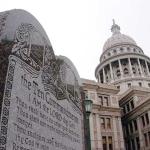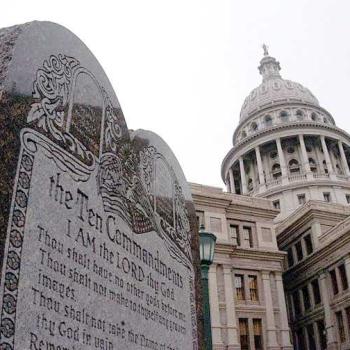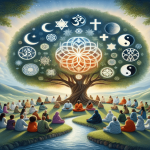I’ve seen claims lately that a Third Great Awakening is happening now. I’m skeptical, but let’s take a look.
What is a Great Awakening? The Great Awakenings of U.S. history were periods of Christian revival that left lasting impacts on American society and culture. The First Great Awakening took place in the colonial period, from the 1730s to the 1760s. This awakening was very much influenced by the European Enlightenment‘s emphasis on rational thinking and science, and it brought about a lot of questioning of old authorities. Historians say the First Great Awakening played a critical role in uniting the colonies and preparing them for declaring independence from Britain. It also set the United States on a path of moving away from hierarchies and nobilities and toward a democratic society of equals. I acknowledge this project still needs work.
The Second Great Awakening followed the Revolution. It lasted from about 1795 to 1835, but its effects continued for many decades after. Indeed, I’d say many of its effects are with us still. The Second was an optimistic and egalitarian movement that stressed the importance of making a personal commitment to Christ. It was the Second that forged American-style evangelical Christianity. But these early evangelicals were a progressive crew who preached that Christ called for making the world a better place for all humankind.
Impact of the Second Great Awakening
An immediate impact of the Second Great Awakening was the emergence of the Abolitionist Movement to end slavery; see “Christianity and the Abolitionist Movement in the U.S.” It also inspired the Temperance Movement, which turned out less well. But in the decades to come the spirit and teachings of the Second Great Awakening also inspired the women’s suffrage movement and a late 19th century movement called the Social Gospel.
Christians of many denominations took part in the Social Gospel. They worked to end child labor and improve working conditions in factories. They addressed living conditions in slums. The first YMCAs were a project of the Social Gospel. By the 1920s the Social Gospel was working to shorten the standard (at the time) 12-hour work day. And the Social Gospel inspired the original Progressive Era in the U.S.
In short, the Second Great Awakening set off a wave of social reforms that culminated in Franklin Roosevelt’s New Deal. See also “When Evangelicals Were Liberal” and “The Progressive Evangelicalism of Jimmy Carter.” Indeed, some historians have argued that the period from 1855 to as late as 1930 was a “Third Great Awakening.” This period saw religious and political progressivism working together for social reform.
The same period also saw other religious movements pulling the nation in the opposite direction, however. And there have been other periods of U.S. history nominated as a “Third Great Awakening,” plus a few have argued there was a “Fourth Great Awakening” in the 1960s and 1970s. Having lived through that one, I have to say it was something of a fizzle.
A Third Great Awakening?
Putting aside whether any new Awakening is the Third, Fourth, or Fifth — claims for this new Third Great Awakening are coming from the political Right. See, for example, “Charlie Kirk and the ‘Third Great Awakening’” by Stephanie McCrummen in The Atlantic. According to McCrummen, before his death the late Mr. Kirk had embraced a movement called the New Apostolic Reformation. “Followers believe that a fresh outpouring of the Holy Spirit is under way, a third ‘Great Awakening,'” McCrummen writes. NAR believes the Holy Spirit is creating new prophets and apostles and activating an Army of God. This will not a metaphorical army but an actual military army. A prominent NAR prophet named Rick Joyner declared that “churches will start being thought of more as military bases than congregations.”
I confess NAR has been off my radar, so I took some time to read everything I could find about it. It’s my understanding that NAR is not a new denomination or even a formal organization. Rather, it is a network of like-minded individuals. This network crosses Christian denominational lines and geographic boundaries. Some other Patheos writers already have addressed NAR. See, for example, “The New Apostolic Reformation, A Threat Within The Church?” and “Is The New Apostolic Reformation Biblical?” I also found a very good backgrounder at Religion Dispatches — see “A Reporter’s Guide to the New Apostolic Reformation.”
And see “3 Key Facts Christians Should Know about the New Apostolic Reformation” at Christianity.com. This last one is by James Spencer, president of the D.L. Moody Center. Moody was a 19th century evangelical who founded the Moody Bible Institute. Moody and his Institute have had a huge influence on conservative Christianity in the U.S. for more than a century. James Spencer explains several theological differences he has with NAR. It is not my place to say who is right or wrong here, but if you are a conservative Christian you might want to read Spencer’s arguments before getting involved with NAR.
Preparing the Way for Jesus?
Not unlike the faithful of earlier awakenings, NAR hopes to prepare the world for the return of Jesus. But instead of doing this by freeing the enslaved and caring for the sick and poor, NAR calls for taking control of all aspects of culture and society, including government. A proposal called the “Seven Mountain Mandate” appears to be the foundation of their purpose. The “seven mountains” are family, religion, education, media, entertainment, business, and government. NAR adherents seek to gain control of the “seven mountains” in order to influence the world and prepare the way for Jesus. Achieving this goal would require eliminating separation of church and state
I’ve read in several sources that NAR proposes the physical world is surrounded by a spiritual dimension. This dimension is full of warring angels and demons. NAR rhetoric is full of accusations that their opponents — anyone who doesn’t want them to control everything — are being controlled by the demons. That would include me, I suppose, and I disagree. A founder and leader of NAR named C. Peter Wagner, who died in 2016, was interviewed by NPR in 2011. He clearly believed that his role was to help cast out all the demons who are, apparently, controlling everyone with views that differed from his. It would be easy to dismiss NAR as just one of many fringe movements that flourish in the U.S. But it has considerable clout within the Republican Party and the Trump Administration.
As I’ve said, I don’t intend to be an arbiter of anyone’s beliefs. But I do know something about history. Whenever any group of people persuades itself that they are on the side of absolute good, and their opponents are forces of absolute evil, they are an inch away from giving themselves permission to eliminate the Other by any means. Between that and the group’s propensity for war rhetoric, I’d say this bears watching.
A New Great Awakening?
Our previous Awakenings not only strengthened Christianity in America but also led to greater national unity and a host of beneficial social reforms. Even the not-fondly remembered Temperance Movement managed to get Americans to drink a lot less. I’m not seeing a potential for that unity or social reform here. The NAR movement seems less of a new Great Awakening and more of a long-delayed backlash to the previous Awakenings. To conclude, I’m going with no, it’s not a Third (or any other number) Great Awakening.

Shuang Wang | Dreamstime.com











